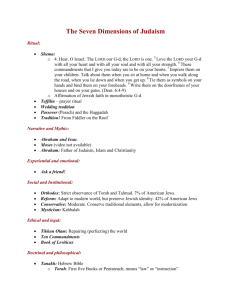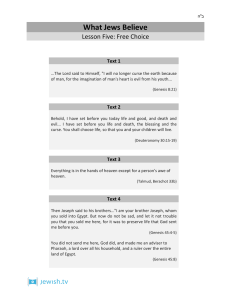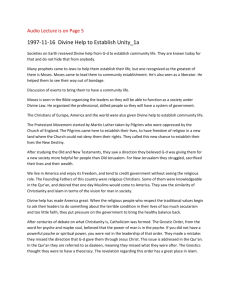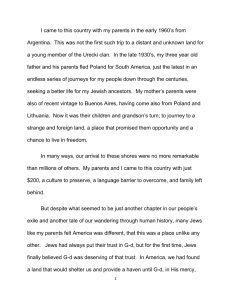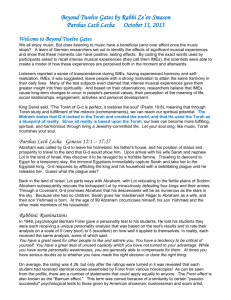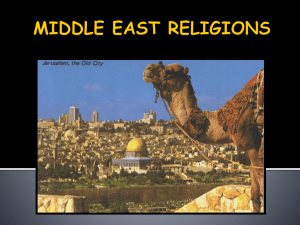Yom Kippur "
advertisement
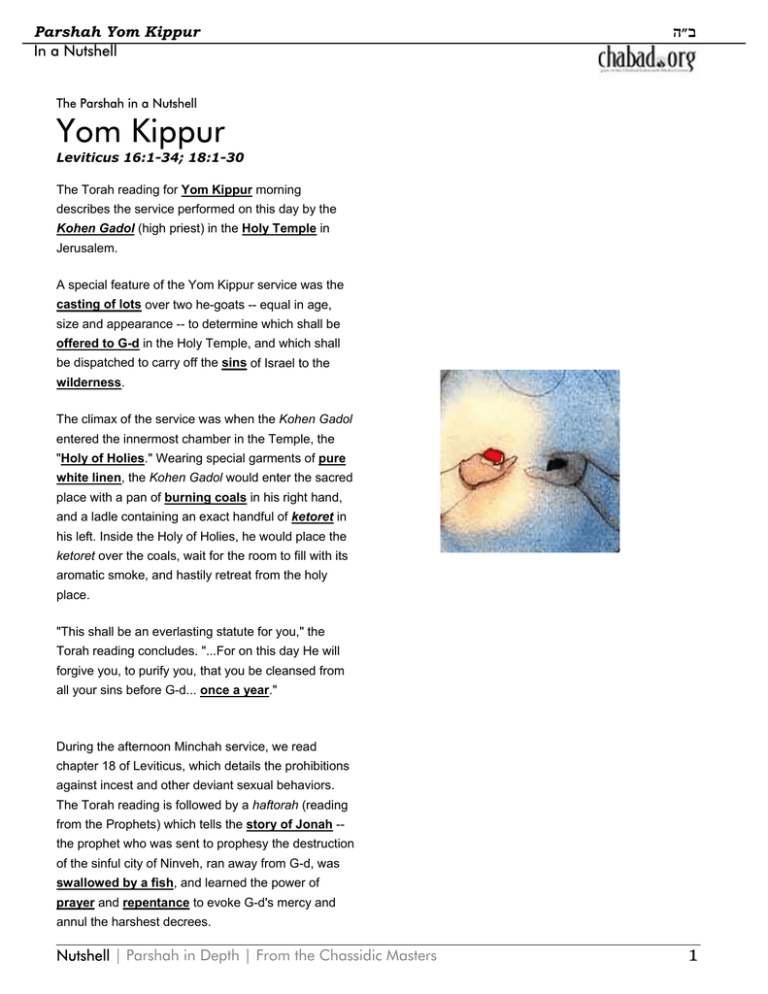
Parshah Yom Kippur In a Nutshell " The Parshah in a Nutshell Yom Kippur Leviticus 16:1-34; 18:1-30 The Torah reading for Yom Kippur morning describes the service performed on this day by the Kohen Gadol (high priest) in the Holy Temple in Jerusalem. A special feature of the Yom Kippur service was the casting of lots over two he-goats -- equal in age, size and appearance -- to determine which shall be offered to G-d in the Holy Temple, and which shall be dispatched to carry off the sins of Israel to the wilderness. The climax of the service was when the Kohen Gadol entered the innermost chamber in the Temple, the "Holy of Holies." Wearing special garments of pure white linen, the Kohen Gadol would enter the sacred place with a pan of burning coals in his right hand, and a ladle containing an exact handful of ketoret in his left. Inside the Holy of Holies, he would place the ketoret over the coals, wait for the room to fill with its aromatic smoke, and hastily retreat from the holy place. "This shall be an everlasting statute for you," the Torah reading concludes. "...For on this day He will forgive you, to purify you, that you be cleansed from all your sins before G-d... once a year." During the afternoon Minchah service, we read chapter 18 of Leviticus, which details the prohibitions against incest and other deviant sexual behaviors. The Torah reading is followed by a haftorah (reading from the Prophets) which tells the story of Jonah -the prophet who was sent to prophesy the destruction of the sinful city of Ninveh, ran away from G-d, was swallowed by a fish, and learned the power of prayer and repentance to evoke G-d's mercy and annul the harshest decrees. Nutshell | Parshah in Depth | From the Chassidic Masters 1 Yom Kippur Summary and Commentary www.Chabad.org Yom Kippur Following the deaths of Leviticus 16:1-34; 18:1-30 Nadav and Avihu, who Summary and Commentary " came close to G-d and died," G-d tells Moses to instruct Aaron ...that he should not enter, at all times, into the holy, inside the Parochet (the "veil" that separated the "Holy of Holies" from the rest of the Sanctuary), before the Kaporet (cover) that is upon the Ark -- lest he die; for in a cloud I appear above the Kaporet... Only on the holiest day of the year -- Yom Kippur -- and after bringing a series of specially ordained offerings, should the Kohen Gadol ("high priest") purify himself, put on white linen garments, and enter the chamber housing the Ark: And he shall place the ketoret upon the fire before Gd; and the cloud of incense shall cover up the Kaporet that is on [the Ark of] the Testament... The Torah then goes on to detail the service performed by the Kohen Gadol on Yom Kippur to secure atonement for his people. Among the offerings of the day were two male goats: And Aaron shall cast lots upon the two goats: one lot for G-d, and one lot for Azazel. The goat that which the lot determined to be "For G-d" is brought as an offering and its blood is sprinkled in the Holy of Holies. The one deemed for "Azazel" is "dispatched by the hand of an appointed man into the wilderness; and the goat shall bear upon it all their sins to a barren land." And he shall make atonement for the holy place, over the defilements of the children of Israel, over their transgressions in all their sins. And so shall he do for the Tent of Meeting, which dwells amongst them in the midst of their defilement... He shall take a pan-full of fiery coals from atop the altar that is before G-d, and the fill of his hands of finely-ground ketoret (incense), and bring them inside the Parochet. Commentary And this shall be an everlasting statute for you: in the seventh month, on the tenth day of the month, you shall afflict your souls, and do no work at all, the home born or the stranger that sojourns among you. came close: After the death of the two sons of Aaron who came close to G-d and died (Leviticus 16:1) They approached the supernal light out of their great love of the Holy, and thereby died. Thus they died by "divine kiss" such as experienced by the perfectly righteous; it is only that the righteous die when the divine kiss approaches them, while they died by their approaching it... Although they sensed their own demise, this did not prevent them from drawing near to G-d in attachment, delight, delectability, fellowship, love, kiss and sweetness, to the point that their souls ceased from them. (Ohr HaChaim) white linen garments: And he shall bathe his flesh in water, and clothe himself in them (16:4) On that day, the Kohen Gadol immersed (in a mikveh) five times, and washed his hands and feet from the kiyyor ("basin") that stood before the Sanctuary ten times: each time he changed his clothes, he was required to immerse once, and wash twice (once before removing the first set of clothes, and again after dressing in the second set). For there were five sets of services performed by him on that day: 1) The regular morning services, performed in the "golden garments" (worn by the Kohen Gadol throughout the year). 2) The special services of the day (reciting the confession over the Yom Kippur offerings, casting the lots, entering the Holy of Holies to offer the ketoret and to sprinkle the blood of the Yom Kippur offerings)-performed in the linen garments. 3) The two rams brought as "ascending offerings" and the day's musaf offerings--in the golden garments. 4) returning to the Holy of Holies to remove the pan of burning incense--in linen garments. 5) the regular afternoon services--in the golden garments. (Talmud, tractate Yoma) " For on this day He will atone for you, to cleanse you, that you may be clean from all your sins before G-d... once a year. Commentary cast lots: Two he-goats (16:5) They should be identical in appearance, height and price, and should be acquired together. (Talmud, Yoma 62b) dwells amongst them in the midst of their defilement: And so shall he do for the Tent of Meeting, which dwells amongst them in the midst of their defilement (16:16) Also when they are in a state of defilement, the Shechinah (Divine Presence) dwells with them. (Talmud; Rashi) this day: For on this day, He shall atone for you (16:30) On Yom Kippur, the day itself atones... as it is written, For on this day... shall atone for you. (Maimonides) Nutshell | Parshah in Depth | From the Chassidic Masters 2 Yom Kippur From the Chassidic Masters The Four Meanings Of Sin Based on the teachings of the Lubavitcher Rebbe, Rabbi Menachem M. Schneerson The Midrash recounts the following dialogue on the significance of sin: Wisdom was asked: What is the fate of the transgressor? Wisdom replied: "Evil pursues iniquity" (Proverbs 13:21). Prophecy was asked: What is the fate of the transgressor? Prophesy replied: "The soul that sins, it shall die" (Ezekiel 18:20). The Torah was asked: What is the fate of the transgressor? Torah replied: He shall bring a guilt-offering, and it shall atone for him (Leviticus, ch. 5). G-d was asked: What is the fate of the transgressor? G-d replied: He shall do teshuvah, and it shall atone for him. 1) The Philosophical Perspective So a transgression is more than a spiritually "unhealthy" deed -- it is an act of spiritual suicide. In the words of the prophet Ezekiel, "The soul that sins, it shall die," for to transgress the Divine will is to sabotage the lifeline of vitality that connects the soul to its source. Our sages echo the prophetic perspective on sin when they state: "The wicked, even in their lifetimes, are considered dead... The righteous, even in death, are considered alive." 3) The Guilt-Offering The Torah has yet a more penetrating view on the dynamics of transgression. It, too, recognizes that the essence of a person's life is his relationship with G-d. But the Torah also perceives the superficiality of evil -- the fact that "a person does not sin unless a spirit of insanity enters into him." The soul of man, which is "literally a part of G-d above," "neither desires, nor is able, to separate itself from G-d." It is only a person's animal self -- the material and selfish drives which overlay his G-dly soul -- who might, at times, take control of his life and compel him to act in a manner that is completely at odds with his true self and will. Because the Torah perceives the superficiality of sin, it can guide the transgressor through a process by which he can undo the negative effects of his transgression--a " www.Chabad.org The concept of "reward and punishment" is one of the fundamental principles of Jewish faith. But punishment for wrongdoing, say our sages, is no more G-d's "revenge" than falling to the ground is Divine retribution for jumping out the window or frostbite is G-d's punishment for a barefoot trek in the snow. Just as the Creator established certain laws of cause and effect that define the natural behavior of the physical universe, so, too, did He establish a spiritual-moral "nature," by which doing good results in a good and fulfilling life and doing evil results in negative and strifeful experiences. This is the philosophical perspective on sin and punishment, expressed by King Solomon in the abovequoted verse from Proverbs. "Evil pursues iniquity" -- the adverse effects of sin are the natural consequences of acts that run contrary to the Creator's design for life. 2) The Prophet's View Prophecy, which is G-d's empowerment of man to cleave to and commune with Him, has a deeper insight into the significance of sin. The essence of life is connection with G-d. "And you who cleave to G-d," says Moses to the people of Israel, at the end of their physically and spiritually perilous 40-year journey through the desert, "are all alive today." "Love the L-rd your G-d," he also enjoins them, "for He is your life." process by which the transgressor recognizes the folly and self-destructiveness of his deed and reinstates his true, G-dly self as the sovereign of his life. This process culminates with the transgressor's bringing of a korban (animal sacrifice) as an offering to G-d, signifying his subjugation of his own animal self to the spark of Gdliness within him. In this way, the "guilt-offering" achieves atonement for sin. Only the most external self was involved in the transgression in the first place; by renouncing the deed as "animal behavior" and subjugating the beast within to serve the soul's G-dly aims, the transgressor restores the integrity of his relationship with the Almighty. 4) What G-d Sees There is one thing, however, that the philosophical, prophetic and Torahic perspectives on sin have in common: the transgression was, and remains, a negative phenomenon. "Wisdom" sees it as the harbinger of evil in a person's life. "Prophecy" sees it as antithetical to life itself. Torah delves deeper yet, revealing the root cause of sin and providing the key to the transgressor's rehabilitation; but even after the atonement prescribed by the Torah, the transgression itself remains a negative event. Torah itself defines certain deeds as contrary to the Divine will; so Nutshell | Parshah in Depth | From the Chassidic Masters 3 Yom Kippur From the Chassidic Masters " www.Chabad.org nothing in Torah can change the fact that a transgression constitutes a betrayal of the relationship between G-d and man. sparks which the Torah has empowered us to extricate from their mundane embodiment and actively involve in our positive endeavors. G-d, as the author of wisdom, the bestower of prophesy and the commander of Torah, is the source of all three perspectives. But He also harbors a fourth vision of sin, a vision that is His alone: sin as the potential for teshuvah. Obviously, the "bound" elements of creation also have a role in the realization of the Divine purpose outlined by the Torah. But theirs is a "negative" role -- they exist so that we should achieve a conquest of self by resisting them. There is no Torah-authorized way in which they can actively be involved in our development of creation, no way in which they may themselves become part of the "dwelling for G-d" that we are charged to make of our world. Of these elements it is said, "Their breaking is their rectification." They exist to be rejected and defeated, and it is in their defeat and exclusion from our lives that their raison detre is realized. The Forbidden Realm The commandments of the Torah categorize the universe into two domains: the permissible and the forbidden. Beef is permissible, pork is forbidden; doing work on the first six days of the week is permissible, to do so on Shabbat is not; the trait of compassion is to be cultivated, and that of haughtiness is to be eliminated. Chassidic teaching explains that this is more than a list of do's and don'ts: it is also a catalog of realizable and unrealizable potentials. Every created entity possesses a "spark" of Divine energy that constitutes its essence and soul--a spark that embodies its function within the Divine purpose for creation. When a person utilizes something-be it a physical object or force, a trait or feeling, or a cultural phenomenon--toward a G-dly end, he brings to light the Divine spark at its core, manifesting and realizing the purpose for which it was created. While no existence is devoid of such a spark -- indeed, nothing can exist without the pinpoint of divinity that imbues it with being and purpose -- not every spark can be actualized through man's constructive use of the thing in which it is invested. There are certain "impregnable" elements -- elements with which the Torah has forbidden our involvement, so that the sparks they contain are inaccessible to us. Thus, for example, one who eats a piece of kosher meat and then uses the energy gained from it to perform a mitzvah, thereby "elevates" the spark of divinity that is the essence of the meat, freeing it of its mundane incarnation and raising it to a state of fulfilled spirituality. However, if one would do the same with a piece of non-kosher meat-meat that G-d has forbidden us to consume--no such elevation would take place. Even if he applied the energy to positive and G-dly ends, this would not constitute a realization of the Divine purpose in the meat's creation, since the consumption of the meat was an express violation of the Divine will. This is the deeper significance of the Hebrew terms assur and mutar employed by Halachah (Torah law) for the forbidden and the permissible. Assur, commonly translated as "forbidden," literally means "bound"; this is the halachic term for those elements whose sparks the Torah has deemed bound and imprisoned in a shell of negativity and proscription. Mutar ("permitted"), which literally means "unbound," is the halachic term for those The Man in the Desert These are the rules that govern our existence and our service of G-d. One who lives by these rules, establishing them as the supreme authority over his behavior, attains the status of tzaddik ("perfectly righteous"). Yet our sages tell us that there is an even higher level of closeness to G-d--that "in the place where baalei teshuvah ("returnees"; penitents) stand, utter tzaddikim cannot stand." The tzaddik is one who has made the Divine will the very substance of his existence. Everything that becomes part of his life--the food he eats, the clothes he wears, the ideas and experiences he garners from his surroundings-are elevated, their "sparks" divested of their mundanity and raised to their Divine function. And he confines himself to the permissible elements of creation, never digressing from the boundaries that Torah sets for our involvement with and development of G-d's world. The baal teshuvah, on the other hand, is one who has digressed; one who has ventured beyond the realm of the permissible and has absorbed the irredeemable elements of creation into his life. His digression was a wholly negative thing; but having occurred, it holds a unique potential: the potential for teshuvah, "return." Teshuvah is fueled by the utter dejection experienced by one who wakes to the realization that he has destroyed all that is beautiful and sacred in his life; by the pain of one who has cut himself off from his source of life and well-being; by the alienation felt by one who finds himself without cause or reason to live. Teshuvah is man's amazing ability to translate these feeling of worthlessness, alienation and pain into the drive for rediscovery and renewal. The baal teshuvah is a person lost in the desert whose thirst, amplified a thousandfold by the barrenness and aridity of his surroundings, drives him to seek water with an intensity that could never have been called forth by the Nutshell | Parshah in Depth | From the Chassidic Masters 4 Yom Kippur From the Chassidic Masters most proficient welldigger; a person whose very abandonment of G-d drives him to seek Him with a passion the most saintly tzaddik cannot know. A soul who, having stretched the cord that binds it to its source to excruciating tautness, rebounds with a force that exceeds anything experienced by those who never leave the Divine orbit. In this way, the baal teshuvah accomplishes what the most perfect tzaddik cannot: he liberates those sparks of divinity imprisoned in the realm of the forbidden. In his soul, the very negativity of these elements, their very contrariness to the Divine will, becomes a positive force, an intensifier of his bond with G-d and his drive to do good. This is teshuvah, "return," in its ultimate sense: the reclaiming of the "lost" moments (or days, or years) and energies of a negative past; the restoration of sparks imprisoned in the lowliest realms of creation; the magnified force of a rebounding soul. Good and Evil But what of the "bindings" that imprison these sparks? If the tzaddik were to employ a forbidden thing toward a positive end, he would fail to elevate it; indeed, the deed would drag him down, distancing him, rather than bringing him closer, to the G-d he is presuming to serve. From where derives the baal teshuvah's power to redeem what the Torah has decreed "bound" and irredeemable? In its commentary on the opening verses of Genesis, the Midrash states: At the onset of the world's creation, G-d beheld the deeds of the righteous and the deeds of the wicked... "And the earth was void and chaotic..." -- these are the deeds of the wicked. "And G-d said: ‘Let there be light'" -- these are the deeds of the righteous. But I still do not know which of them He desires... Then, when it says, "And G-d saw the light, that it is good," I know that He desires the deeds of the righteous, and does not desire the deeds of the wicked. In other words, the only true definition of "good" or "evil" is that "good" is what G-d desires and "evil" is what is contrary to His will. The fact that we instinctively sense certain deeds to be good and others to be evil -- the fact that certain deeds are good and certain deeds are evil -is the result of G-d having chosen to desire certain deeds from man and to not desire other deeds from man. We cannot, however, speak of good and evil "before" G-d expressly chose the "deeds of the righteous." On this level, where there is nothing to distinguish right from wrong, we cannot presume to know what G-d will desire. " www.Chabad.org Therein lies the difference between the tzaddik and the baal teshuvah. The tzaddik relates to G-d through his fulfillment of the Divine will expressed in the Torah. Thus, his achievements are defined and regulated by the Divine will. When he does what G-d has commanded to be done, he elevates those elements of creation touched by his deeds. But those elements with which the Divine will forbids his involvement are closed to him. The baal teshuvah, however, relates to G-d Himself, the formulator and professor of this will. Thus, he accesses a Divine potential that, by Torah's standards, is inaccessible. Because his relationship with G-d is on a level that precedes and supersedes the Divine will--a level on which one "still does not know which of them He desires"--there are no "bound" elements, nothing to inhibit the actualization of the Divine potential in any of G-d's creations. So when the baal teshuvah sublimates his negative deeds and experiences to fuel his yearning and passion for good, he brings to light the sparks of Gdliness they hold. To Be and To Be Not What enables the baal teshuvah to connect to G-d in such a way? The tzaddik's ability to relate to G-d through the fulfillment of His will was granted to each and every one of us when G-d gave us the Torah at Mount Sinai. But what empowers the baal teshuvah to reach the "place where utter tzaddikim cannot stand" and tap the "pre-will" essence of G-d? The thrust of the baal teshuvah's life is the very opposite of the tzaddik's. The tzaddik is good, and the gist of everything he does is to amplify that goodness. The baal teshuvah had departed from the path of good, and the gist of everything he does is to deconstruct and transform what he was. In other words, the tzaddik is occupied with the development of self, and the baal teshuvah, with the negation of self. Thus the tzaddik's virtue is also what limits him. True, his development of self is a wholly positive and G-dly endeavor--he is developing the self that G-d wants him to develop, and by developing this self he becomes one with the will of G-d. But a sense of self is also the greatest handicap to relating to the essence of G-d, which tolerates no camouflaging or equivocation of the truth that "there is none else besides Him." The baal teshuvah, on the other hand, is one whose every thought and endeavor is driven by the recognition that he must depart from what he is in order to come close to G-d. This perpetual abnegation of self allows him to relate to G-d as G-d is, on a level that transcends G-d's specific projection of Himself formulated in His Torah. Nutshell | Parshah in Depth | From the Chassidic Masters 5 Yom Kippur From the Chassidic Masters The Fourth Dimension This is G-d's perspective on sin: sin as the facilitator of teshuvah. "Wisdom," "prophecy" and "Torah" are all part of a reality polarized by good and evil; they can perceive only the damage inflicted by sin, or, at most (as in the case of Torah), the manner by which it might be undone. G-d's reality, however, is wholly and exclusively good. "No evil resides with You," sings the Psalmist. In the words of Jeremiah, "From the Supernal do not stem both evil and good." From G-d's perspective, there is only the positive essence of transgression--the positive purpose for which He created man's susceptibility to evil and his capacity for sin in the first place. As viewed by its Creator, transgression is the potential for a deeper bond between Himself and man--a bond borne out of the transformation of evil into good and failure into achievement. Reverse Biology " www.Chabad.org In truth, however, a fast day brings about a deeper, rather than more distant, relationship with the body. When a person eats, he is nourished by the food and drink he ingests. On a fast day, vitality comes from the body itself - from energy stored in its cells. In other words, on less holy days, it is an outside force (the energy in one’s food and drink) that keeps body and soul together; on Yom Kippur, the union of body and soul derives from the body itself. Yom Kippur thus offers a taste of the culminating state of creation known as the "World to Come." The Talmud tells us that "in the World to Come, there is neither eating nor drinking" -- a statement that is sometimes understood to imply that in its ultimate and most perfect state, creation is wholly spiritual, devoid of bodies and all things physical. Kabbalistic and Chassidic teaching, however, describe the World to Come as a world in which the physical dimension of existence is not abolished, but is preserved and elevated. The fact that there is "neither eating or drinking" in the World to Come is not due to an absence of bodies and physical life, but to the fact that in this future world, "the soul will be nourished by the body" itself, and the symbiosis of matter and spirit that is man will not require any outside sources of nutrition to sustain it. Two Vehicles Baseed on the teachings of the Lubavitcher Rebbe, Rabbi Menachem M. Schneerson And this shall be an everlasting statute for you: in the seventh month, on the tenth day of the month, you shall afflict your souls... Leviticus 16:29 In the World to Come, there is neither eating nor drinking... Talmud, Berachot 17a The human being consists of a body and a soul -- a physical envelope of flesh, blood, sinew and bone, inhabited and vitalized by a spiritual force described by the Chassidic masters as "literally a part of G-d above." Common wisdom has it that spirit is loftier than matter, and the soul holier (i.e., closer to the Divine) than the body. This conception seems to be borne out by the fact that Yom Kippur, the holiest day of the year -- the day on which we achieve the height of intimacy with G-d -- is ordained by the Torah as a fast day, a day on which we seemingly abandon the body and its needs to devote ourselves exclusively to the spiritual activities of repentance and prayer. The physical and the spiritual are both creations of G-d. Both were brought into being by Him out of utter nothingness, and each bears the imprint of its Creator in the particular qualities that define it. The spiritual, with its intangibility and its transcendence of time and space, reflects the sublimity and infinity of G-d. The spiritual is also naturally submissive, readily acknowledging its subservience to a higher truth. It is these qualities that make the spiritual "holy" and a vehicle of relationship with G-d. The physical, on the other hand, is tactual, egocentric and immanent -- qualities that brand it "mundane" rather than holy, that mark it as an obfuscation, rather than a manifestation, of the divine truth. For the unequivocal "I am" of the physical belies the truth that "there is none else besides Him" -- that G-d is the sole source and end of all existence. Ultimately, however, everything comes from G-d; every feature of His every creation has its source in Him and serves to reveal His truth. So on a deeper level, the very qualities that make the physical "unholy" are the qualities that make it the most sacred and G-dly of G-d’s creations. For what is the "I am" of the physical if not an echo of the unequivocal being of G-d? What is the tactility of the physical if not an intimation of the absoluteness of His reality? What is the "selfishness" of the physical if not an offshoot, however remote, of the exclusivity of G-d Nutshell | Parshah in Depth | From the Chassidic Masters 6 Yom Kippur From the Chassidic Masters expressed in the axiom "There is none else besides Him"? Today, the physical world shows us only its most superficial face, in which the divine characteristics stamped in it are corrupted as a concealment, rather than a revelation, of G-dliness. Today, when the physical object conveys to us "I am," it bespeaks not the reality of G-d but an independent, self-sufficient existence that challenges the divine truth. But in the World to Come, the product of the labor of a hundred generations to sanctify the material world, the true face of the physical will come to light. In the World to Come, the physical will be no less a vehicle of divinity than the spiritual. In fact, in many respects, it will surpass the spiritual as a conveyor of Gdliness. For while the spiritual expresses various divine characteristics -- G-d’s infinity, transcendence, etc. -- the physical expresses the being of G-d. Today, the body must look to the soul as its moral guide, as its source of awareness and appreciation of all things divine. But in the World to Come, "the soul will be nourished by the body." The physical body will be a source of divine awareness and identification that is loftier than the soul’s own spiritual vision. Yom Kippur is a taste of this future world of reverse biology. It is thus a day on which we are "sustained by hunger," deriving our sustenance from the body itself. On this holiest of days, the body becomes a source of life and nurture rather than its recipient. Ketoret Based on the teachings of the Lubavitcher Rebbe, Rabbi Menachem M. Schneerson And he shall take a censer-full of burning coals from the altar, and the fill of his hands of finely-ground ketoret; and he shall bring [these] inside the curtain. And he shall place the ketoret upon the fire before G-d; and the cloud of the incense shall envelop the covering of the [Ark of] Testimony Leviticus 16:12-13 " www.Chabad.org Man's quest to serve his Creator is perpetual and allconsuming, and can be pursued by all people, at all times, and in all places. There was one event, however, that represented the apogee in the human effort to come close to G-d--an event that brought together the holiest day of the year, the holiest human being on earth, and the holiest place in the universe: on Yom Kippur the Kohen Gadol (High Priest) would enter the innermost chamber of the Holy Temple in Jerusalem, the Holy of Holies, to offer ketoret to G-d. The offering of the ketoret was the most prestigious and sacred of the services in the Holy Temple. The ketoret was a special blend of eleven herbs and balms whose precise ingredients and manner of preparation were commanded by G-d to Moses. Twice a day, ketoret was burned on the golden altar that stood in the Temple. On Yom Kippur, in addition to the regular ketoret offerings, the Kohen Gadol would enter the Holy of Holies with a pan of smoldering coals in his right hand and a ladle filled with ketoret in his left; there, he would scoop the ketoret into his hands, place it over the coals, wait for the chamber to fill with the fragrant smoke of the burning incense, and swiftly back out of the room. The moment marked the climax of the Yom Kippur service in the Holy Temple. Maimonides describes the function of the ketoret as the vanquishing of the unpleasant odors that might otherwise have pervaded the Holy Temple. Since many animals were slaughtered in the sacred place each day, their flesh butchered and burnt and their intestines cleaned, its smell would doubtless have been like the smell of a slaughterhouse.... Therefore G-d commanded that the ketoret be burned twice a day, each morning and afternoon, to lend a pleasing fragrance to [the Holy Temple] and to the garments of those who served in it. But Maimonides' words carry a significance that extends beyond their superficial sense. In the words of Rabbeinu Bechayei, G-d forbid that the great principle and mystery of the ketoret should be reduced to this mundane purpose. Chassidic teaching explains that the animal sacrifices offered in the Holy Temple represent the person's offering of his own animal soul to G-d--the subjugation of his natural instincts and desires to the divine will. This is the deeper significance of the foul odor emitted by the sacrifices which the ketoret came to dispel: the animal soul of man, which is the basic drive, common to every living creature, for self-preservation and selfenhancement, possesses many positive traits which can be directed toward gainful and holy ends; but it is also the source of many negative and destructive traits. When a person brings his animal self to the Temple of G-d and offers what is best and finest in it upon the altar, there is still the foul odor--the selfishness, the brutality and the materiality of the animal in man--that accompanies the process. Hence the burning of the ketoret, which Nutshell | Parshah in Depth | From the Chassidic Masters 7 Yom Kippur From the Chassidic Masters possessed the unique capability to sublimate the evil odor of the animal soul within its heavenly fragrance. Essence and Utility This, however, still does not define the essence of the ketoret. For if the more external parts of the Temple might be susceptible to the foul odor emitted by the animal souls offered there, the Holy of Holies was a sanctum of unadulterated holiness and perfection; no animal sacrifices were offered there, for this part of the Temple was exclusively devoted to sheltering the Ark of Testament that held the tablets upon which G-d had inscribed the Ten Commandments. If the garments (i.e., character and behavior) of the ordinary priest might be affected by the negative smell of the slaughtered beasts he handled, this was certainly not the case with the Kohen Gadol, the greatest of his brethren in the fraternity of divine service. If every day of the year the scent of evil hovers at the periphery of even the most positive endeavor, Yom Kippur is a day in which there is no license for the forces of evil to incriminate. If the ketoret was offered by the Kohen Gadol in the Holy of Holies on Yom Kippur, its ultimate function could not be the sublimation of evil. The sublimation of evil is something that only the ketoret can achieve, but this is not the sum of its purpose and function. The word ketoret means bonding; the essence of the ketoret is the pristine yearning of the soul of man to cleave to G-d--a yearning that emanates from the innermost sanctum of the soul and is thus free of all constraints and restraints, of all that inhibits and limits us when we relate to something with the more external elements of our being. Its purity and perfection are what give the ketoret the power to sweeten the foulest of odors, but dealing with evil is not what it is all about. On the contrary, its highest expression is in the utterly evil-free environment of the Holy of Holies on Yom Kippur. " www.Chabad.org healing potion for the ills of the soul. But teshuvah is also the dominant quality of Yom Kippur, the holiest day of the year. Obviously, there is more to teshuvah than the rectification of sin. The word teshuvah means return: return to pristine beginnings, return to the intrinsic perfection of the soul. For the essence of the soul of man, which is a spark of Gdliness, is immune to corruption. The inner self of man remains uninvolved in the follies of the ego, untouched by the outer self's enmeshment in the material and the mundane. Teshuvah is the return to one's true self, the cutting through of all those outer layers of misguided actions and distorted priorities to awaken one's true will and desire. This explains how teshuvah achieves atonement for past sins. Teshuvah enables the sinner to reconnect with his own inherent goodness, with that part of himself which never sinned in the first place. In a sense, he has now acquired a new self, one with an unblemished past; but this new self is really his own true self come to light, while his previous, corrupted self was but an external distortion of his true being. Only teshuvah has such power over the past; only teshuvah can undo a negative deed. But this is only one of the uses of the power of return. Teshuvah is not only for sinners, but also for the holiest person in the holiest time and the holiest place. For even the perfectly righteous individual needs to be liberated from the limitations of the past. Even the perfectly righteous individual is limited--limited because of knowledge not yet acquired, insights still ungained, feelings yet to be developed, attainments still unachieved; in a word, limited by time itself and the tyranny of its one way only law. As we advance through life, we conquer these limits, gaining wisdom and experience and refining and perfecting our character. But is our ability to grow and achieve limited to the future only? Is the past a closed frontier? Bringing the Past in Line Today, the Holy Temple no longer stands in Jerusalem, and the Kohen Gadol enters the Holy of Holies only in our recitation of the account of the Yom Kippur Temple service in the prayers of the Holy Day and in our vision of a future Yom Kippur in the rebuilt Temple. But the ketoret remains a basic component of our service of G-d in general, and of our observance of Yom Kippur in particular. We are speaking, of course, of the spiritual ketoret, which exists within the human soul as the power of teshuvah. When we adopt the inward-seeking approach of teshuvah in everything we do, we need not leave an imperfect past behind at the waysides of our lives. In a teshuvah state, when we learn something new, we uncover the deeper dimension of our self which was always aware of this truth; when we refine a new facet of our personality, we bring to light the timeless perfection of our soul. Never satisfied in merely moving forward, our search for our own true self remakes the past as well. Based on the teachings of the Lubavitcher Rebbe; adapted by Yanki Tauber Like the incense that burned in the Holy Temple, the manifest function of teshuvah is to deal with negative and undesirable things. On the day-to-day, practical level, teshuvah is repentance--a response to wrongdoing, a Nutshell | Parshah in Depth | From the Chassidic Masters 8
